When we think of carnivorous plants, most of us imagine enormous carnivorous plants that eat humans and animals from science fiction or horror movies.
But these protein-eating plants are actually aesthetically beautiful and quite interesting to cultivate. They can offer a unique addition to your indoor houseplant collection.
The Carnivorous Plant
While most plants nourish themselves through photosynthesis, a small group of plants eats bugs and insects for nutrients. In some cases, they may even advance to eating frogs and small animals.
Carnivorous plants do not actually “eat” bugs. They will trap prey using nectar to attract insects into leaf traps. Once the bug is captured, the plant will release a digestive enzyme to extract nutrients from the insect and absorb them. Some plants are passive trappers, while others use movement to cage their prey.
Carnivorous plants are found worldwide, usually in bog environments. This type of environment will be watery and offer very little nourishment. These plants evolved as carnivorous plants due to a lack of nourishment, and particularly nitrogen, in the soil. They simply began to find their own meals.
Let’s take a look at some of the most popular carnivorous plants that eat flies and other bugs.
Best Carnivorous Plants that Eat Insects
1. Venus Flytrap
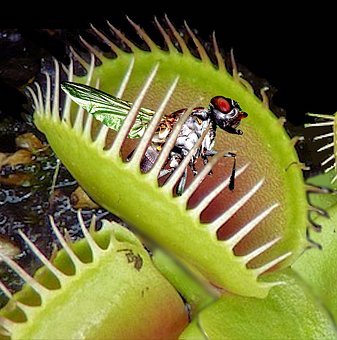
Belonging to the Droseraceae family, the Dionaea muscipula, or Venus Flytrap is unique in appearance and probably the most famous of carnivorous plants. This plant generally eats flies and is characterized by its “fly trap,” which is a modified leaf.
Plants are able to grow up to eight traps. The Venus fly trap leaf features two lips or lobes that join naturally. Nectar is produced inside the lips as bait to lure insects. When an insect enters, it triggers the plant’s hairs and the trap springs shut.
The insect will find itself trapped inside a natural cage formed by the flytrap’s interlocking plant teeth. The trap will seal around the struggling insect. Digestive enzymes proceed to dissolve and absorb soft tissue.
Depending on the kind of insect, digestion will take four to ten days. The dead insect carcass remains to attract other insects once the jaws reopen.
Native to areas along the North and South Carolina coast, the plant’s survival is at risk due to environmental damage. Although it has been considered somewhat difficult to cultivate, it can be done. It is easier to grow outdoors.
When cultivating, light should be bright but indirect and diffuse. Keep the soil moist and the soil pH levels on the acidic side between 5.6 and 6.0. Average home room temperatures are perfect for this.
2. Butterwort Plant
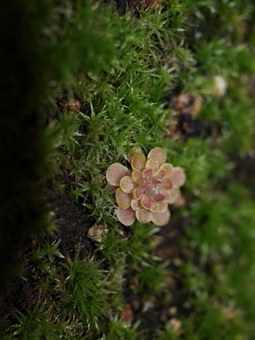
The Butterwort Plant is a very small plant that features yellow-green foliage. It will produce tiny flowers in the springtime in a variety of white, yellow, pink, or purple. Botanically named the Pinguicula, this unassuming plant is actually deadly to insects that happen upon it.
The butterwort differs from other carnivorous plants as it does not use movement to capture insects. It produces a resin coating on its foliage to trap the bugs as they land on leaves. Feeding principally on gnats, the butterwort will release a digestive enzyme as the bug struggles to free itself to obtain the necessary nourishment.
Moderately bright light requirements mean this plant can grow well on windowsills. Soil should be moist with watering from a saucer placed underneath the pot. An alkaline pH lover, the pH level should remain higher than 7.2. Temperatures between 60° and 80°F are ideal.
3. Lobster Pot Plant
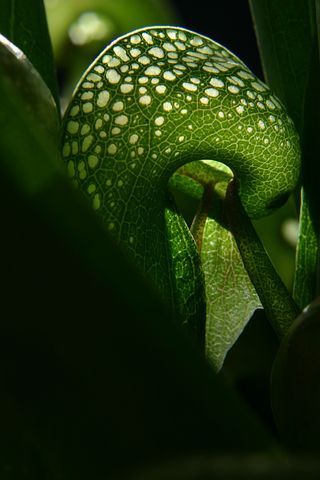
Also known as the Cobra Lily or California Pitcher Plant, the Darlingtonia californica appears in shape to be very similar to the pots used for catching lobster. Native to Northern California and Oregon, when an insect enters the plant’s “pot” it can no longer flee.
The Lobster-Pot plant hairs will keep the insects unable to fly away. Its sticky hairs force the insects down into the leaf to be digested.
A difficult carnivorous plant to cultivate, outdoors it enjoys full sun to some shade and will produce blooms that vary from yellow to green with a purplish tint. It is related to other Sarraceniaceae family tropical pitcher plants.
Able to grow to three feet tall, they are quite visible. They are also thought to resemble a cobra about to strike, hence its Cobra Lily name. When cultivated indoors, they like lots of indirect light. When outdoors, partial shade is recommended.
The soil bed should always be damp and its pH lightly acidic, between 6.1 and 6.5. Preferred temperatures should measure between 40° and 80° F.
4. Monkey Cup Plant
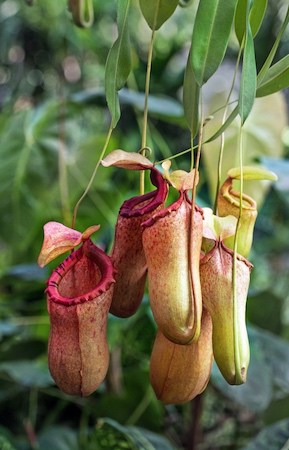
The Nepenthes is a tropical carnivorous plant found in Malaysia, Sumatra, and Borneo. It is popularly called the Monkey Cup Plant because, in their native rainforest habitats, monkeys have been known to drink water from their cups.
The plant’s vines produce leaves that are a kind of pitcher and they are known to hold large amounts of water. These cups may collect and hold water for dryer periods, but their usefulness isn’t limited to this.
They are complex passive traps nature has designed for nourishment. The cups secrete an acidic digestive liquid. Insects are attracted by both their color and the nectar they produce. Because the cups’ rims and sides are slippery, insects fall into the liquid where they are digested, and nutrients are absorbed by the plant.
Bright light and conditions similar to cultivating orchids will make for a happy monkey cup plant. The Nepenthes attenboroughii is one of the larger carnivorous plants in existence and it is endangered.
It can attain heights of five feet with pitchers measuring a foot in width. This Nepenthes doesn’t stop at bugs as its size allows it to also feed on rodents.
5. Pitcher Plant
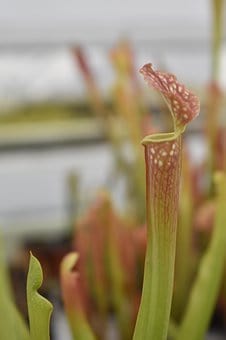
Native to the southern United States in some areas in Mississippi and Louisiana where soil beds are poor in nutrients, Pitcher Plants feature tubes or funnels that are actually traps for smaller animals and insects.
The pitcher plant will secrete a nectary substance as bait into its pitchers. When a bug enters the plant’s cup, fluids will digest the insect into a kind of nutritional soup that the plant will then feed on.
Roughly eighty types of well-known Pitcher plants can be found with genus names Sarracenia, Darlingtonia, and Nepenthes. With vase-shaped leaves, pitcher plants are quite fascinating to cultivate, whether indoors or outdoors.
With the correct environmental conditions, they require little care and will be an interesting addition to a home garden, terrarium, or outdoor garden.
Full direct sunlight and a permanently wet soil bed are suggested. This plant likes acidic soil, so the pH can measure anywhere from 3.0 to 7.0. A temperature between 65° to 85° F is best.
6. Sundew Plant
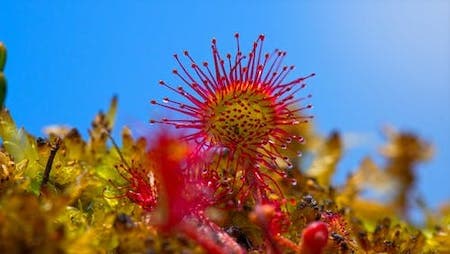
Botanically named Drosera capensis, the Sundew Plant survives by feeding on insects. Most likely named for their unique appearance, the foliage is characterized by long tentacles with each bearing a sticky gland at the tip making them glisten.
There are about 150 sundew plant species. The family is the Droseraceae with three genera and numerous sundew species. Hybrids occur both naturally and bred by breeders.
These perennial plants can be found internationally just about everywhere. Temperate Sundews will grow well in mild climates, while Petiolaris Sundews prefer hot climates. Growing characteristics are quite diverse, including both tiny and larger plants, as well as vining plants.
The sundew uses adhesive to trap prey, like flypaper. Leaf tentacles have tips with nectar glands. The nectar is a digestive juice that is sticky, so insects get stuck in this adhesive. Once stuck, leaf tentacles will embrace the plant’s victim until it suffocates. Digestive enzymes absorb the nutrients the victim provides.
The sundew needs approximately six hours of direct sunlight exposure daily. The soil should always remain moist, so a water saucer underneath the pot is a good idea. Soil pH needs to be a bit acidic, measuring between 5.5 and 6.5. Ideal temperatures will measure between 50° and 95° F.
7. Brocchinia Reducta
The Brocchinia reducta is a rare carnivorous bromeliad, as well as a succulent. However, unlike other bromeliads, it is not an epiphyte, but rather it’s terrestrial.
With pineapple leaf shapes, the plant forms a rosette of fleshy sleek foliage with a green to bluish or grayish green tint and lightly striped. Initially, they grow upright, but gradually open outward and can grow to a foot in height and in width.
Generally feeding on houseflies and mosquitoes, it features a liquid in its center cup that will digest unlucky insects that fall inside. This carnivorous plant is characterized by a pleasant fragrance. The Brocchinia likes lots of light, but it should be diffused and never exposed to strong, direct sunlight.
This plant can be watered from above and the soil needs to remain consistently humid. The plant’s central cup can be filled with a little water, but it should not overflow. The soil pH level should be kept lower than 7.0 and room temperatures should measure between 70° to 85° F.
Where Can Carnivorous Plants be Found?
Because carnivorous plants can be found worldwide, their habitats may vary. However, two things that the habitats will have in common is that they will be wet and soil will be low in nutrients.
Common habitats include bogs, sandy locations, swamps, rocky sites, forests, watercourses, and other bodies of water.
How Do Carnivorous Plants Trap Insects?
Carnivorous plants use a few methods for catching their next meal. Some produce strong-smelling nectar or use beauty with vivid, intense colors that resemble flowers. Some are so well camouflaged that they may not be recognized after they have trapped.
But these plants have a very good sense of survival and the need for pollinating insects. They produce flowers often at the end of very long stems and away from the foliage that traps.
Trapping methods include:
- Adhesive Nectar: These plants use sticky nectar to suffocate victims. Sometimes tentacles will wrap around the victim as it struggles to free itself.
- Snap Trapping: Traps are triggered by the plant’s tiny trigger hairs. As the victim lands, these sensitive hairs snap the leaf blades shut.
- Pitfall Trapping: These traps are characterized by slippery rims and sides so that the insect falls into a digestive liquid.
- Suction Traps: These are typically used by aquatic versions of carnivorous plants. When the prey is near, a trapdoor valve opens, creating a suction movement that pushes the victims inside. Once the victim has entered, the door swings shut to seal.
- Snare Trapping: Snare traps use a disguess to successfully trap. These traps appear to be roots. When a protozoan or ciliate comes nears, attracted by chemicals, it will enter through opening slits in tubular formations where they are directed right into a digestive bladder.
Carnivorous Plant Care
Because these plants live in bogs as their natural habitat, they have specific needs for their care that differ from other houseplants.
Soil and Growing Medium
To replicate the natural habitat, carnivorous plants will want well-draining soil that is kept consistently moist. For the ideal soil bed, a 50/50 blend of coarse sand and sphagnum peat moss will be good for retaining water and provide enough acidity to keep a carnivorous plant happy.
Never use regular potting soil. Some carnivorous plants prefer alkaline growing mediums, while others prefer acidic soil beds. It’s important to get the acidity level right for the carnivorous plant that you have selected.
Water
To keep your carnivorous plant roots adequately wet, place the plant’s container in a saucer or dish filled with water. Avoid watering these plants with tap water or even spring water because the water tends to be heavy in mineral content, which the plant won’t like.
A better choice would be collected room-temperature rainwater or distilled water. These plants are also great selections for open terrariums because they thrive in high humidity.
Light
Carnivorous plants appreciate bright sunlight, so when cultivating indoors, consider a south-facing window. Patios, balconies, and porches are also good location options.
They can be moved out of the sunlight during dormancy and to a cooler location. Dormancy will usually occur beginning in November until February.
Feeding Nutritional Needs
The challenge with cultivating carnivorous plants indoors is in feeding them, as most homes will not be filled with insects. Bugs, such as flies you catch, or swat can be fed to your plant.
If you don’t have a sufficient supply of bugs, you can purchase bloodworms from your local aquarium or pet store. Generally, one insect per week will provide sufficient nutrition for your plant.
Carnivorous Plants Final Thoughts
There are many different types of carnivorous plants available today. They come in various sizes, shapes, colors, and textures. Find the type of carnivorous plant that works best for you. You may need to experiment with several varieties before finding the perfect fit.
If you decide to grow any kind of carnivorous plant at home, make sure you follow proper care techniques for each one.
Here are some other great lists of houseplants to help you filter through all the options out there:
- Cool and Unique Houseplants
- Best Low Light Plants for Indoor Spaces
- Poisonous Houseplants to Keep Away From Plants
Carnivorous Plants FAQs
What carnivorous plants eat flies?
Carnivorous plants like Venus Flytraps and Pitcher Plants are examples of plants that eat flies. They use different entrapment methods to trap flies, so they can secrete digestive enzymes that will break down the insect for its nutrients.
What is the best carnivorous plant for flies?
The Venus flytrap is one of the best carnivorous plants for flies. This plant has an incredible ability to detect the presence of insects, which triggers the plant to close its trap. When the fly enters the trap, the plant quickly closes it, trapping the insect inside with the digestive enzymes that will break down the insects for nutrients. Sundews and Pitcher Plants are also great carnivorous plants for catching flies.
Do carnivorous plants help with flies?
Yes, carnivorous plants do help with flies because they attract insects to their leaves, which then gets consumed by the plant. As a result, carnivorous plants help to catch annoying insects.
Where can you find carnivorous plants?
Carnivorous plants are found worldwide in wetland areas, like swamps, marshes, and bogs. In the U.S., most of these are in the Southeast, like North Carolina, South Carolina, and Florida. Unfortunately, carnivorous plants are often threatened or endangered in the natural world due to loss of their natural habitat homes and illegal poaching.
Why do carnivorous plants eat insects?
Carnivorous plants evolved in regions where nutrients were scarce. The soil and water in those regions, such as bogs and swamps, do not provide the nutrients that the plants need for survival. To survive, they must eat insects that live in these nutrient-poor areas.







